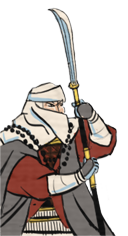
Basic Unit Statistics (can be modified by difficulty level, arts, skills, traits and retainers)
| Upkeep Cost | 0 | |
| Melee Attack | 14 | 40% |
| Charge Bonus | 12 | 24% |
| Bonus vs Cavalry | 10 | 33% |
| Melee Defence | 8 | 22% |
| Armour | 2 | 13% |
| Morale | 15 | 30% |
Strengths & Weaknesses
- Versatile infantry, good against cavalry and other infantry.
- Weak armour makes them vulnerable to arrows.
- Weak against matchlocks.
- Not as strong as more specialised anti-infantry and anti-cavalry units.
Abilities
- Warcry - Warcry heavily demoralises up to four nearby enemy units, slowing them down and affecting their defence ability for a short time.
Requires
- Religions:

Description
These warrior monks wield fearsome naginata: long polearms effective against cavalry and infantry alike.
A warrior with an unshakable faith can be very dangerous, for the truly devout have little to fear from death. For these monks, faith is not just a matter of conscience, but another weapon and one that gives them very good morale in battle. The weapon they carry is a naginata, a long staff with a blade fixed to the end. The polearm's long reach makes it effective against cavalry and infantry, but this versatility is no protection against specialist troops. A naginata was, and still is, a polearm weapon similar to the medieval European glaive: a long, wooden shaft with a curved killing blade. The blade varied in length and was made to the same quality standard as a sword blade. These distinctive looking weapons were closely associated with warrior monks, and most famously used by Gochin no Tajima (Tajima the "arrow cutter") at the battle of Uji in 1180. Gochin was part of a group of samurai and warrior monks pursued by the Taira clan. He made a defensive stand at a bridge, whirling his naginata with such expertise that the enemy's arrows harmlessly bounced away.